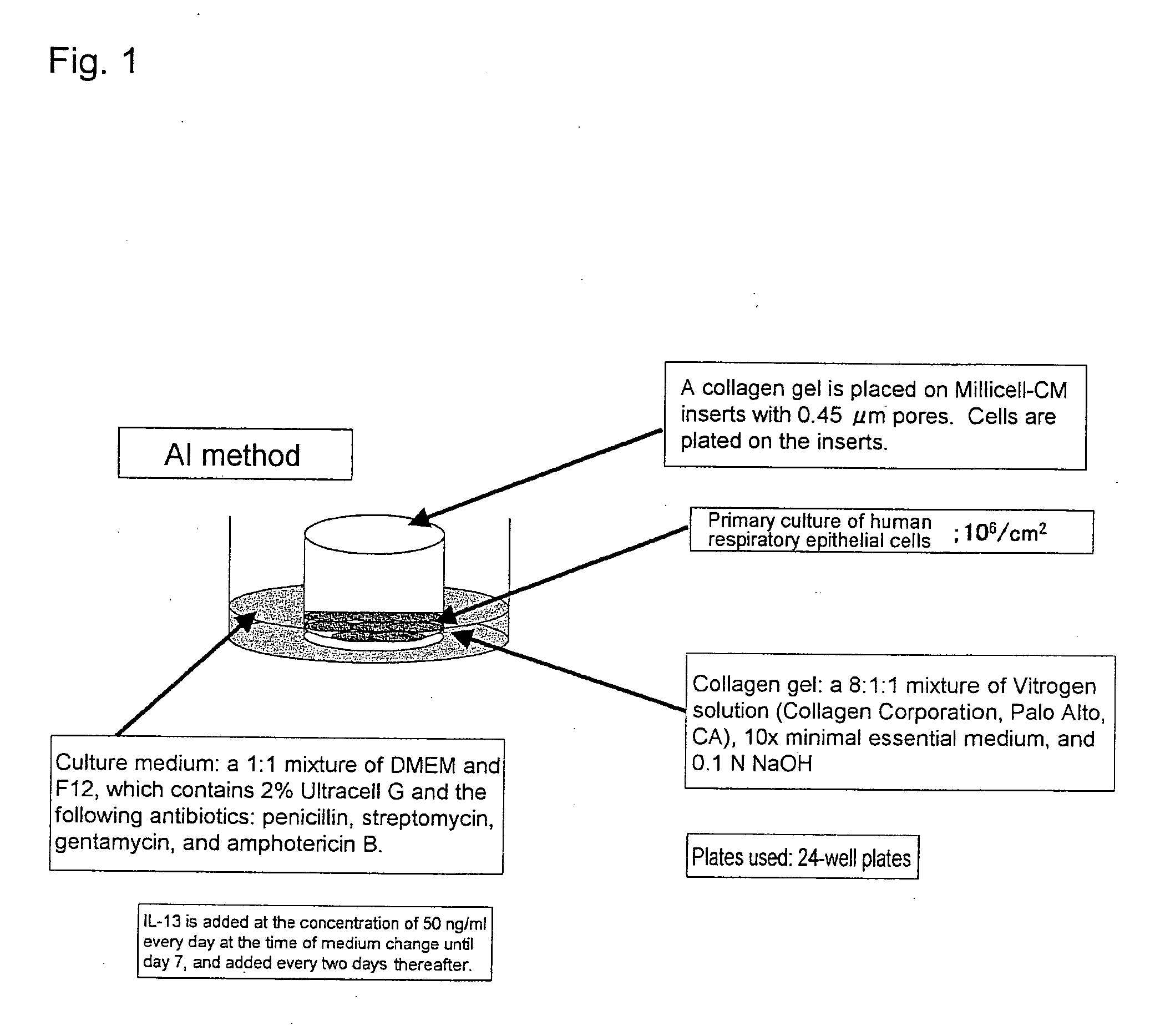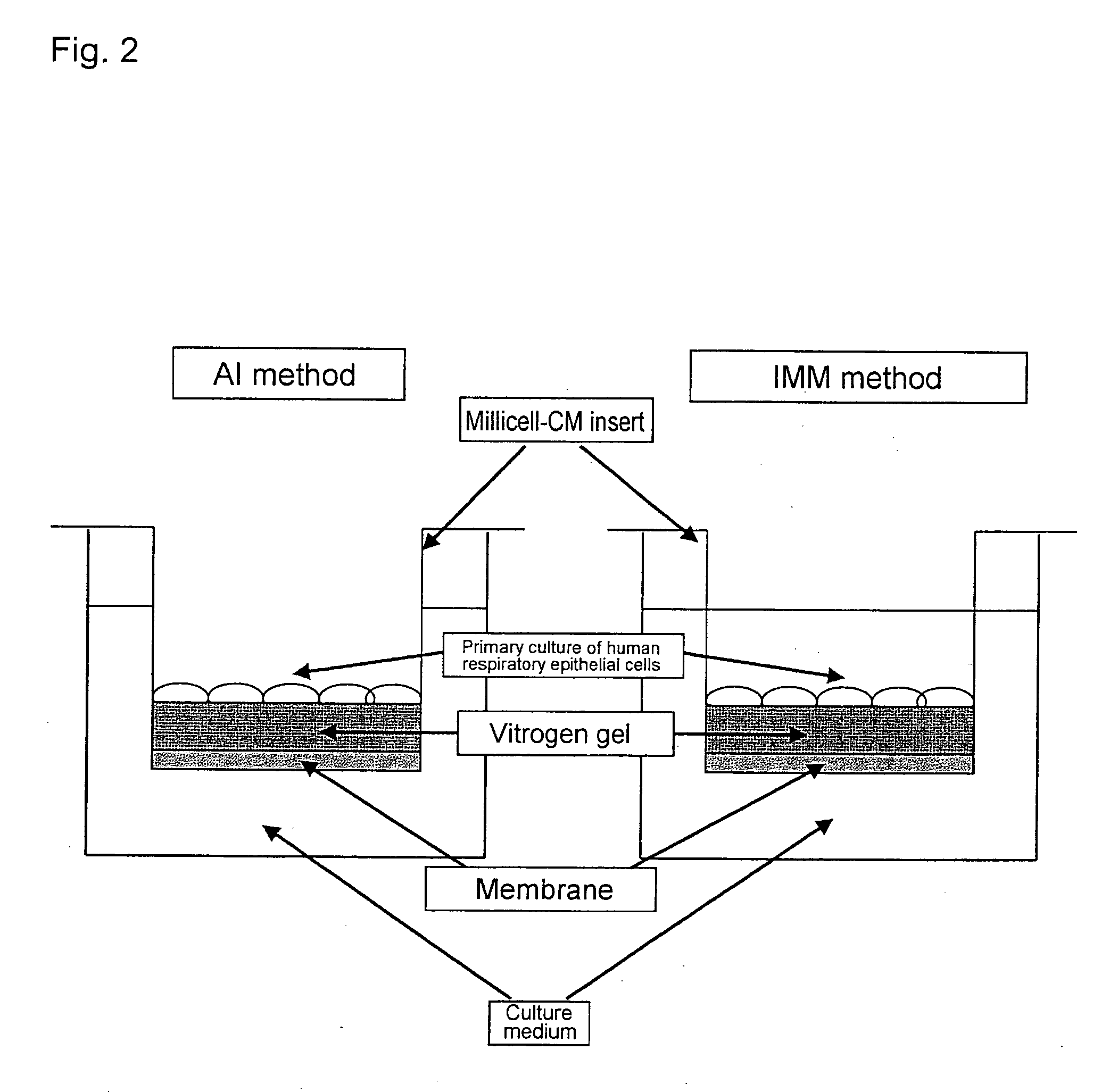Methods of testing for bronchial asthma or chronic obstructive pulmonary disease
a technology of bronchial asthma and obstructive pulmonary disease, which is applied in the direction of instruments, drug compositions, peptide/protein ingredients, etc., can solve the problems of reducing the efficacy of asthma drugs, inhalation steroids and 2 agonists have been reported to have side effects, and the number of asthma patients is increasing rapidly
- Summary
- Abstract
- Description
- Claims
- Application Information
AI Technical Summary
Benefits of technology
Problems solved by technology
Method used
Image
Examples
example 1
The Air Interface (AI) Method and the Immersed Feeding (IMM) Method
1. The Air Interface Method:
[0372] Approval for this study was obtained from the Ethical Committee of the Faculty of Medicine, The Tohoku University, Japan. Tracheal tissues derived from anatomical specimens were stretched on plates. The epithelia were removed and allowed to stand still in phosphate buffer containing protease (0.05%) at 4° C. overnight. The following day, a culture medium containing fetal calf serum was added to the samples to neutralize enzyme activity, and respiratory epithelial cells were isolated by shaking the samples.
[0373] After the cell count was determined, cells were plated at the cell density of 106 cells / cm2 on a filter membrane with 0.45-μm pores, being attached to the bottom of a Millicell-HA Culture Plate Insert (Millipore Corp.). At the time of plating, Vitrogen gel (Vitrogen from Celtrix Pharmaceuticals, Inc. was used after gelation) was placed on the filter membrane as a growth-...
example 2
Stimulation of bronchial epithelial cells with IL-13
[0375] In the AI method in Example 1, human IL-13 (Peprotech, Inc.) was added to the medium at the concentration of 50 ng / mL when changing the medium, every day for 7 days. After 7 days, human IL-13 was added to the medium when the medium was changed, every two days. After 14 days of incubation, cells were treated by PAS staining for acidic sugar chains and Alcian blue staining for basic sugar chains. The result showed that the cells had differentiated into goblet cells comprising a huge glycoprotein, mucin.
[0376] Human IL-13 was also added in the IMM method. However, goblet cell differentiation was not observed. The objective of this study is to screen genes associated with the differentiation of respiratory epithelial cells into goblet cells upon IL-13 stimulation by the AI method. Therefore, instead of completely differentiated day-14 cells, cells that were in the process of undergoing cell differentiation were harvested at da...
example 3
Preparation of RNA for GeneChips
[0377] Respiratory epithelial cells treated by the procedure described above were lysed with ISOGEN (Nippon Gene Co., Ltd.). RNA was isolated from the solution according to the protocol attached to ISOGEN. Chloroform was added to the solution. After the mixture was stirred and centrifuged, the aqueous layer was collected. Then, isopropanol was added to the aqueous solution. After stirring and centrifuging the solution, the precipitated total RNA was collected. Approximately 5 μg to 15 μg total RNAs were extracted from sample Nos. 1 to 12. The total RNAs were analyzed for gene expression using 15 HG-U95A to HG-U95E from Affymetrix. The type A gene chip comprises about 12,000 probes designed based on the information on the nucleotide sequences of full-length cDNAs. Each of the type B, C, D, and E gene chips comprises about 50,000 probes designed based on the information on the nucleotide sequences of ESTs.
PUM
| Property | Measurement | Unit |
|---|---|---|
| Volume | aaaaa | aaaaa |
| Volume | aaaaa | aaaaa |
| Volume | aaaaa | aaaaa |
Abstract
Description
Claims
Application Information
 Login to View More
Login to View More - R&D
- Intellectual Property
- Life Sciences
- Materials
- Tech Scout
- Unparalleled Data Quality
- Higher Quality Content
- 60% Fewer Hallucinations
Browse by: Latest US Patents, China's latest patents, Technical Efficacy Thesaurus, Application Domain, Technology Topic, Popular Technical Reports.
© 2025 PatSnap. All rights reserved.Legal|Privacy policy|Modern Slavery Act Transparency Statement|Sitemap|About US| Contact US: help@patsnap.com



